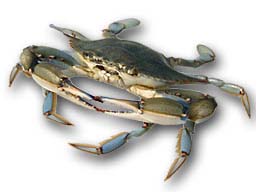
Despite its fearsome appearance and aggressive nature, the blue crab is greatly cherished in the Lowcountry. Many Chefs prefer the blue crab’s sweet meat over all other locally caught seafood. This interesting animal is often sought by recreational fishermen, and it also supports a considerable commercial fishery.
The blue crab requires both inshore brackish waters and high salinity ocean waters to complete its life cycle. They are common from Massachusetts to Texas and a few have been reported as far north as Nova Scotia and as far south as Uruguay. Chesapeake Bay, North Carolina and Louisiana support the largest blue crab fisheries.
Although other small crabs in this family occur locally, only the blue crab is of any commercial or recreational importance in South Carolina. The blue crab’s scientific name, Callinectes sapidus, translates to “savory beautiful swimmer.” Swimming is accomplished by sculling the oar-like fifth pair of legs, the swimming legs. These paddles usually rotate at 20 to 40 revolutions per minute, but they quickly disappear into a blur as the animal darts away. Walking is accomplished with the three pairs of thin walking legs. Blue crabs almost always walk sideways, clearing a path with their sharp lateral spines. The blue crab’s most prominent features are the large and powerful claws, which are used for food gathering, defense, digging and sexual displays. Mature males usually have brilliant blue claws and legs, and mature females can be distinguished by the bright orange tips on their claws. Males typically grow larger than females, sometimes reaching 7 or 8 inches in point-to- point width. Some males have been reported to grow to about 10 inches. If not handled properly, blue crabs can inflict severe injury.
Male crabs can be distinguished from females by the shape of the abdomen. The male has a T-shaped abdomen that is held tightly against the body until maturity when it becomes somewhat free. The immature female has a triangle-shaped abdomen that is tightly sealed against the body. The mature female’s abdomen becomes rounded and can be easily pulled away from the body after the final molt.
Blue crabs eat a variety of foods, including fishes, oysters, clams, snails, shrimp, worms and other crabs. At high tide, crabs may swim into the salt marsh to pluck snails from the tall grass. At times, they burrow into the bottom with only their eye stalks visible, lying in wait for an unsuspecting fish. Crabs are opportunistic feeders, meaning they will eat what is most available regardless of their size, the season or the area they inhabit.
Blue crabs in South Carolina are not only abundant and easy to catch, but their preparation for the table is a simple process. Crabs should be kept alive prior to cooking by keeping them cool and dry. Crabs may be maintained live in a refrigerator or in a cooler with a small amount of ice.
Crabs should never be put into a container of water as they will die quickly from lack of oxygen. Crabs that have been dead for a while spoil very rapidly, and it’s best to discard dead crabs. Crabs that have been chilled may appear dead but will begin showing movement as they warm. If no movement is detected after warming, discard the crab.
A large double boiler is ideal for cooking blue crabs because it allows crabs to be steamed and not boiled. When using a double boiler, wait until the water boils in the lower pot, then place the crabs in the upper pot. If cooking with a single large pot, crabs may be stacked to the top and a few inches of water added to the bottom. Or, the crabs may be completely covered with water. In either case, seasonings may be sprinkled on the crabs or into the water. Some cooks prefer to mix seasonings with cool water in another pot. After cooking, the crabs are moved to the cool, seasoned water and allowed to soak up the seasonings. This prevents overcooking and allows the crabs to become spicier. Cooking generally takes 20 to 30 minutes producing a well-cooked crab with an orange color and meat that has a firm white texture.
